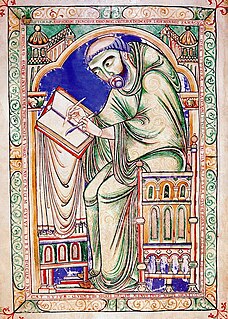Editions
Jean de Mailly, Abbreviatio in gestis et miraculis sanctorum. Supplementum hagiographicum. Ed. Giovanni Paolo Maggioni (Florence, SISMEL/Edizioni del Galluzzo, 2013). ISBN 978-88-8450-368-8.
Jean Pierier of Mailly, called Jean de Mailly, was a Dominican chronicler working in Metz in the mid-13th century. In his Latin chronicle of the Diocese of Metz, Chronica universalis Mettensis, [1] the fable of Pope Joan first appears in written form. [2] He is also the compiler of the Abbreviatio in gestis sanctorum, a collection of legends about the saints which is an important forerunner of the Golden Legend.
Jean de Mailly, Abbreviatio in gestis et miraculis sanctorum. Supplementum hagiographicum. Ed. Giovanni Paolo Maggioni (Florence, SISMEL/Edizioni del Galluzzo, 2013). ISBN 978-88-8450-368-8.
A chronicle is a historical account of events arranged in chronological order, as in a time line. Typically, equal weight is given for historically important events and local events, the purpose being the recording of events that occurred, seen from the perspective of the chronicler. A chronicle which traces world history is a universal chronicle. This is in contrast to a narrative or history, in which an author chooses events to interpret and analyze and excludes those the author does not consider important or relevant.

Pope Joan was, according to legend, a woman who reigned as pope for an unknown number of years during the Middle Ages. Her story first appeared in chronicles in the 13th century and subsequently spread throughout Europe. The story was widely believed for centuries but most modern scholars regard it as fictional.
This article contains information about the literary events and publications of the 13th century.

The Golden Legend is a collection of hagiographies by Jacobus de Voragine that was widely read in late medieval Europe. More than a thousand manuscripts of the text have survived. It was likely compiled around the years 1259–1266, although the text was added to over the centuries.
The papacy has been surrounded by numerous legends. Among the most famous are the claims that the papal tiara bears the Number of the Beast inscriptions, that a woman was once elected pope, or that the current pope will be the last. The latter claim is false for every known pope barring the incumbent, but it remains theoretically possible.

Sigebert of Gembloux was a medieval author, known mainly as a pro-Imperial historian of a universal chronicle, opposed to the expansive papacy of Gregory VII and Pascal II. Early in his life he became a monk in the Benedictine abbey of Gembloux.

The Chronicon Pictum is a medieval illustrated chronicle from the Kingdom of Hungary from the 14th century. It represents the great international artistic style of the royal courts in the court of King Louis I of Hungary. The codex is a unique source of art, medieval and cultural history.

This article presents lists of the literary events and publications in the 12th century.

Joan of Arc is a 1999 Canadian two-part television miniseries about the 15th-century Catholic saint of the same name. The miniseries stars Leelee Sobieski as Saint Joan. A joint production of the Canadian Broadcasting Corporation and Alliance Atlantis Communications, it was shown internationally in 1999.
Philip of Cognac was an illegitimate son of Richard the Lionheart, King of England, by an unidentified mother.
Alpert of Metz was a Benedictine chronicler of the eleventh century. His De diversitate temporum is a major source for the history of Western Europe in the period it covers, which is 990 to 1021. It was dedicated to Burchard of Worms.

Laurent Dailliez was a French history doctor who graduated from Ecole pratique des hautes études. He was a researcher in medieval studies at the CNRS, a historian of the Crusades, and a specialist of the Knights Templar. Among other books, he wrote "Les Templiers". Dailliez was also the author of the article on the Templars in the leading French language encyclopedia, Encyclopedia Universalis.
Saint Terentian(us) was Bishop of Todi who was killed during the reign of Hadrian (117–138).
Francesco da Fabriano - born Francesco Venimbeni - was an Italian Roman Catholic professed member from the Order of Friars Minor. He was a noted writer on various theological and biblical matters and was known for his great breadth of theological knowledge that characterized his religious life.
Guy I of Luxembourg-Ligny was Count of Saint-Pol (1360–1371) and Count of Ligny, Lord of Roussy and Beauvoir (1364–1371).
Joan the Maid is a two-part 1994 French historical film directed by Jacques Rivette. It chronicles the life of Joan of Arc from the French perspective.
The Chronica Romanorum pontificum et imperatorum ac de rebus in Apulia gestis is a 13th-century Latin prose chronicle by an anonymous monk of the monastery of Santa Maria della Ferraria in southern Italy. It is sometimes called the Ferraris Chronicle, Chronica Ferrariensis or Chronicle of Santa Maria di Ferraria. The chronicle was rediscovered in Bologna in the nineteenth century and published in English translation only in 2017.

Chronica Polonorum is a treatise about Polish history and geography written in Latin by a Polish renaissance scholar Maciej Miechowita, a professor of Jagiellonian University, historian, geographer, astrologer, and royal physician of king Sigismund I the Old. Chronica Polonorum was first published in 1519.
Adele was a French noble lady and the Countess suo jure of Bar-sur-Aube.

The Chronica de gestis consulum Andegavorum, or simply Gesta consulum Andegavorum, is a Latin history of the Ingelgerian dynasty of the county of Anjou written in the early 12th century, probably between 1106 and 1109, during the second reign of Count Fulk IV.